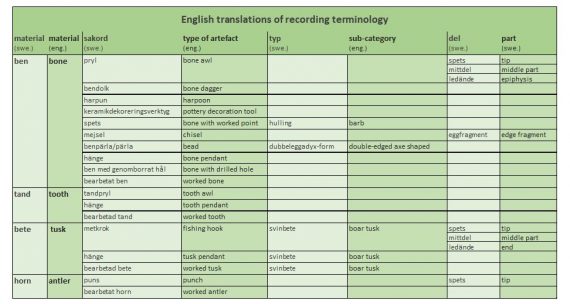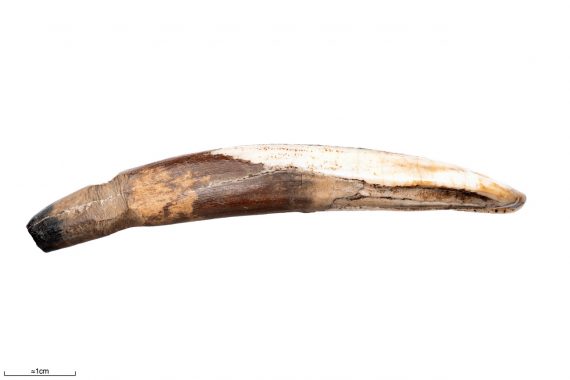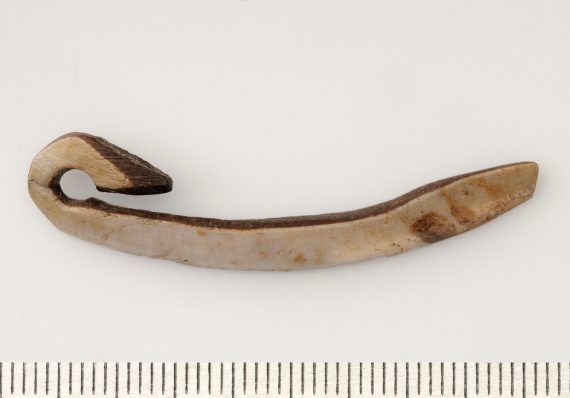Recording bone, tooth, tusk and antler
Recording strategy for the bone, tooth, tusk and antler materials
Artefacts of bone, tooth, tusk and antler found during Malmer’s excavations have been recorded based on previous osteological definitions by Ebba During, definitions that occasionally have been updated within the current project. The artefacts discussed in this text concern objects that clearly have been worked; artefacts that have not been worked are consequently osteological material and have been recorded accordingly.
Basic information concerning context, year of excavation, material and osteological definitions have been noted for every record. The length of the artefact has been recorded when the object is considered intact, additional information is recorded as keywords: class or species (in latin), type of bone (in latin), proximal/distal part of the bone (Sw. proximalt/distalt) and left or right side of the bone; sinister/dexter (latin). These key words are recorded in line with how osteological material is recorded in the museum database, in the following order: ulna, distalt, sinister. Traces of production and use-ware are recorded as key words.
Other relevant information such as the sex of the animal, possible cleaving (Sw: kluvet) of the bone, additional observations etc. can be found in the description field (Sw: beskrivning). Artefacts that previously underwent conservation are labelled as follows konserverad (Eng. conserved), PEG 1000 (Eng. conserved, PEG 1000) or fryskonserverad (freeze conserved/freeze dried). This information can be found in the comments column (Sw: anmärkning).
Worth noticing is that the recording strategy within the current project is somewhat different from Browall (2011); the definitions used to describe the artefacts are the same, but the descriptive information has been added as key words in the museum database rather than as a description (see fig. 1 for separate list of key words with English translations).

Fig.1. English translations of terms used in the recording of artefacts made of bone, tooth, tusk and antler. The terminology as it is recorded in the database is displayed in Swedish and English. Table by Nathalie Hinders, Sandra Söderlind and Jacqueline Taffinder.
Method
The material categories presented below are characterised individually based on what raw material was used to make them i.e. bone, tooth, tusk or antler. It is of importance to note that the current project has recorded artefacts of tooth and tusk separately; in line with how the osteological material is recorded at SHM. This is a noticeable difference from the material from Frödin’s investigations where artefacts made of tusk are registered as tooth (Browall 2011: 322-332).
The different types of artefacts have been recorded in line with the definitions in Browall (2011:295-332 and cited work therein), the definitions of the artefact categories are presented below. A few categories have been added within the current project, such as: bone with drilled hole and bone with worked point.
A few categories have been re-defined within the current project, namely bead and pendant. Browall (2011) defines these categories based on the raw material used in the following manner; bone beads (swe. rörpärlor), tooth beads (swe. pärlor) and tusk pendants (swe. hängen). The recording of beads and pendants within the current project however, defines beads and pendants based on where the drilled hole/grooves are located without regards to raw material. When a drilled hole is centred/drilled through an artefact it is called bead and when a drilled hole/grooves are placed on one side/part it is called pendant.
Artefacts of bone
The bone artefacts were registered in line with the methodology described above. The artefacts made of bone consist of bone awls, bone daggers, harpoons, pottery decoration tools, bone with worked point, chisels, bone with drilled hole and worked bone.

Fig. 2. Object number 1209859. Awl, bone. Photo: Ola Myrin, Swedish History Museum, SHM.
Bone awl
An awl is defined as a bone element, partially or fully cleaved with a worked sharp, tip and a blunt end, usually made up of the bone’s natural epiphysis. Fragmented awls were recorded in the museum database with the remaining parts of the awl accounted for. The different parts of the awl are recorded as following: tip (swe. spets), middle part (swe. mittdel) and epiphysis (Sw. ledände). Complete awls are recorded without stating the remaining parts.
Bone dagger
Bone daggers are primarily made of ulna. The epiphysis is a part of the handle/grip. The opposing end of the handle/grip is sometimes worked into a pointed tip. The surfaces close to the tip and the tip itself are the most worked surfaces on the bone daggers, objects that are otherwise sparsely worked.
Harpoon
Harpoons are defined as pointed bone artefacts with smaller or larger barbs on one or two sides of the bone. Harpoons can also be tanged.
Pottery decoration tool: small awl/other pottery decoration tool
The group of artefacts defined as pottery decoration tools can best described as small awls (see Hinders 2017). These objects are similar in their own entity but deviant from the larger awls. The small awls are most likely pottery decoration tools and they have been prepared in the same manner as the larger awls, and it is clear that this shape was intended:
“…where the mid-section begins on the larger awls the points of the smaller ones is already formed /…/ Although a small awl could be reworked from a broken larger awl, or quite possibly from a bone element intended to form a larger artefact, the shape and traces of meticulous grinding to obtain the desired shape of the small point are evidently quite intentional” (Hinders 2017:124).
The artefacts within this group do not correspond to other artefact categories and the interpretation of their function as pottery decoration tools is plausible (Hinders 2017; see Browall 2011:306; 331 for details regarding decoration tools in Frödin’s material).

Fig. 3. Object number 1254459. Small awl. Photo: Ola Myrin, SHM.
Bone with a worked point
Bones with a worked point is a group of fragmented objects or objects with undetermined shape, making it difficult to define their function. This broad term includes only one specific type, namely barb (swe. hulling); most artefacts with worked point are recorded without a defined type. It should be noted that some artefacts with worked points and some tips of awls share similar characteristics, though the artefacts with worked points are often too small or, for other reasons, impossible to defined as awls.
Chisel
Bone chisels are artefacts with one side consisting of a sharp, straight edge and an opposing blunt end. The chisels are often cleaved, lengthwise. The epiphysis is sometimes kept as a handle, but can also be removed. Many of the chisels show signs of grinding and smoothing on the sharp edge.
Fragmented chisels were recorded in the museum database with the remaining parts of the chisel accounted for. The different parts of the chisel are recorded as following: tip (swe. spets), middle part (swe. mittdel) and epiphysis (swe. ledände). Complete chisels are recorded without stating the remaining parts.
Bead
Beads have drilled holes for suspension that perforate the centre of the objects (see Method above).
Bone with a drilled hole
The group of artefacts defined as bone with drilled hole is most commonly made of toe bone, yet, objects made from long bone occur. The bones are largely unworked except for the edges of the bone element which are often rounded or worn.
Worked bone
Worked bone is a broad category of clearly worked bone artefacts however, fragmented in a way that makes it difficult to define their function.
Artefacts of tooth
The artefacts made of tooth were registered in line with the methodology described above. The different types of artefacts consist of tooth awls, beads and worked tooth.
Tooth awl
Tooth awls are defined and recorded as awls made of bone.
Pendant
Pendants recorded within the current project are mostly made of tooth or tusk but can also be made of bone or antler. Pendants have drilled holes or grooves at one side for suspension.

Fig. 4. Object number 1209759. Tooth pendant. Photo: Ola Myrin, Swedish History Museum, SHM.
Worked tooth
Worked tooth is a broad category of clearly worked tooth however, fragmented in a way that makes it difficult to define their function.
Artefacts of tusk from boar
The artefacts made of tusk from boar were registered in line with the methodology described above. The different types of artefacts consist of fish hooks, pendants and worked tusk. Artefacts made of tusk from boar were defined as tooth by Browall (2011). It is worth noting that tusks of boar are separated into a specific category within the current project. Objects made of boar tusk are recorded as follows: Type (sakord) varies depending on the type of artefact subtype (Sw. typ) is recorded as svinbete (tusk of boar) and the material as bete (tusk).
Fishing hook
Fishing hooks are made of the tusk using the natural form and then enhanced and worked into a hook shape. The different parts of the fishing hook are recorded as tip (Sw. spets), middle part (swe. mittdel) and end (swe. ände). Complete fishing hooks are recorded without stating the remaining parts.

Fig. 5. Object number 1188532. Fishing hook, boar tusk. Photo: Gabriel Hildebrand, SHM.
Worked tusk
Worked tusk is a broad category of clearly worked tusks however fragmented in a way that makes it difficult to define their function.
Artefacts of antler
The artefacts made of antler are registered in line with the methodology described above. The different types of artefacts consist of punches and worked antler.
Punch
Browall (2011:320-322), separates punch tools in to two categories based on size and usage. Both types were used in lithic industry. One type of punch is described as being made of a longer tine which was used as a tool for pressure technique (Sw. tryckstock); the other type of punch was made of shorter tines, used for indirect percussion (Sw. mellanstycke; Browall 2011:320-322). In the current project all antler tools used for knapping have been recorded as punches. Complete punches are recorded without stating the remaining parts, occasionally, tips of punches (Sw. spets) are recorded.
Worked antler
Worked antler is a broad category of clearly worked antler however, fragmented in a way that makes it difficult to define their function.
Text: Nathalie Hinders, Sandra Söderlind.
The following reference on this page has no web link:
Browall, H. 2011. Alvastra pålbyggnad, 1909-1930 års utgrävningar. Kungl. Vitterhets Historie och Antikvitets Akademien. Handlingar. Antikvariska serien 48. Stockholm.